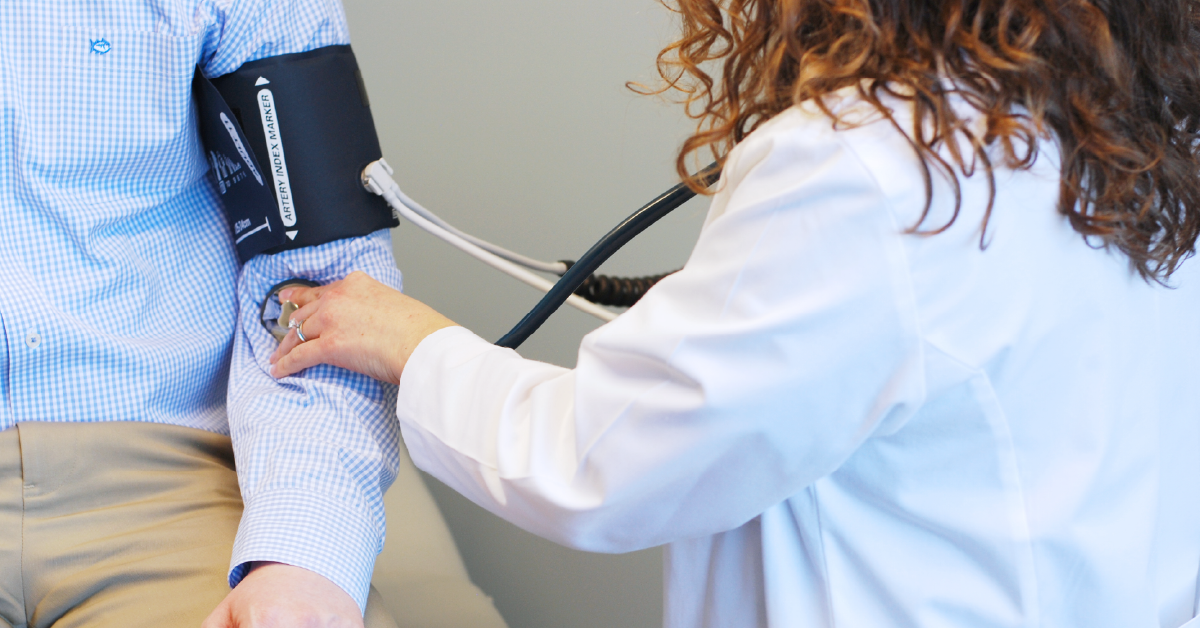
In the symphony of our bodily functions, high blood pressure often strikes a dissonant chord, subtly influencing our well-being until it crescendos into a serious health concern. This silent threat, also known as hypertension, is a common but potentially dangerous condition that affects millions worldwide.
Tryon Medical Partners internal medicine specialist Dr. Claire Wilder weighs in on the intricacies of high blood pressure, explores its pervasive impact, and sheds light on the proactive measures we can take to harmonize our cardiovascular health.
What is high blood pressure?
Dr. Wilder defines high blood pressure as a condition in which the force of the blood on the artery walls is above a normal level. High blood pressure is important to detect and treat because chronic hypertension can strain organ systems and cause disease like heart failure, kidney disease, and a predisposition to heart attack and stroke. High blood pressure is particularly insidious because it impacts multiple parts of the body and often occurs without symptoms.
What do blood pressure numbers mean?
There are two numbers that are critical to understanding blood pressure. The first is the top number, systolic blood pressure, which indicates the pressure of the heart while it’s contracting. The second number is the bottom number, diastolic blood pressure, which indicates the pressure of the heart at rest. The bottom number, the diastolic, is especially important to monitor because the heart spends more time in a resting state.
Ideal blood pressure numbers are under 130 on top and under 80 on the bottom. The upper limit is clearly defined – blood pressure above 130/80 is too high and puts you at risk of the harm hypertension can cause. Unlike high blood pressure, the definition for low blood pressure is more flexible and depends on whether a person has symptoms of low blood pressure such as lightheadedness, racing heart, or fatigue. However, anything less than 90 on the top and less than 60 on the bottom is potentially too low. It is important to note that lower blood pressure is also relatively common in younger people and athletes.
“Our goals shift as the research on blood pressure shifts,” Dr. Wilder explains. “We used to aim for under 140 for the top number and under 90 for the bottom number but more data has shown lower than that, like 130 and 80, is even better.”
What causes high blood pressure?
Two big factors can impact high blood pressure:
- Genetics and family history. Some people inherit genetics that make it more likely for them to develop high blood pressure. For instance, if both of your parents have high blood pressure, you are more likely to as well.
- Lifestyle. Factors like excess body weight, a diet that is high in salt, lack of regular exercise, and eating heavily processed foods can predispose you to hypertension.
What are the symptoms of high blood pressure?
Although hypertension often has no symptoms, making it a silent threat, symptoms will eventually appear if the high blood pressure becomes extreme. Dr. Wilder recommends seeing your clinician as soon as possible if you’re experiencing any of the following symptoms:
- Headaches
- Shortness of breath
- Chest discomfort
- Blurry vision
“If you notice any of these symptoms, it is very important to be evaluated,” Dr. Wilder emphasizes. “Hypertension is often silent at first. By the time you’re feeling symptoms, the pressure could be running high for a long time or severely elevated.”
How can I prevent high blood pressure?
There are many ways to prevent high blood pressure from developing. Dr. Wilder recommends:
- Regular visits to see your clinician. Consistently seeing your healthcare team to have your blood pressure checked is critical in making sure it’s within healthy bounds. Don’t skip your annual wellness visit.
- Sharing family medical history. Because family medical history can help predict what you might experience, communicating any family history of hypertension to your care team will be critical in providing you with the proper attention.
- Maintaining a healthy diet. Eating a balanced diet, especially staying away from excess sodium, sets you up well for a healthy blood pressure.
- Getting regular exercise. Incorporating consistent movement into your daily life will help control your blood pressure.
How do you treat high blood pressure?
Dr. Wilder explains that treatment options depend on the severity of the hypertension as well as history of other medical conditions.
In general, she recommends:
- Incorporating the DASH diet. DASH (Dietary Approaches to Stop Hypertension) recommends eating vegetables, fruits, whole grains, fish, poultry, beans, nuts, and vegetable oils, and limiting foods that are high in saturated fat, such as fatty meats, full-fat dairy products, and tropical oils (coconut, palm kernel, and palm oils), as well as sugar-sweetened beverages and sweets.
- Prioritizing regular exercise. Dr. Wilder suggests exercising 30 minutes a day, 5 days a week, at a moderate intensity. This could be anything from brisk walking to jogging, as opposed to high intensity exercise like a run.
- Considering medication. If lifestyle changes aren’t bringing down the blood pressure, medication should be considered. Dr. Wilder recommends consulting your clinician on the best options for your specific situation.
- Measuring blood pressure at home. Getting a blood pressure cuff and regularly measuring at home can help you better understand how different habits impact your blood pressure, such as exercising or eating a certain meal.
“More recent guidance in 2017 recommends lowering the threshold at which medication is considered for blood pressure management,” Dr. Wilder notes. “This is why keeping up with regular visits with your clinician is critical. Regular visits will help you and your clinician understand any changes in blood pressure so they can provide the best solution for you, whether it’s a lifestyle or pharmacologically-based change that is necessary.”
If you can’t remember the last time you were cuffed, schedule an appointment with your primary care clinician today.

